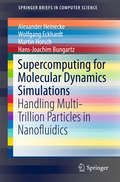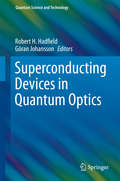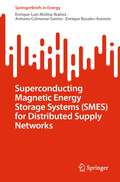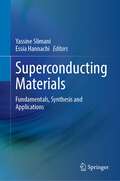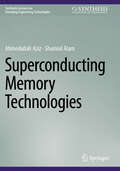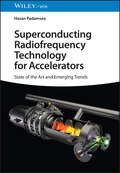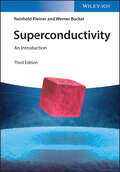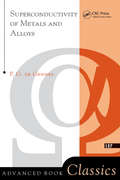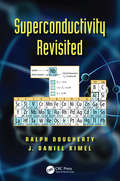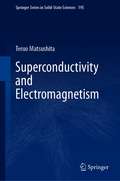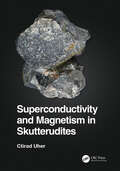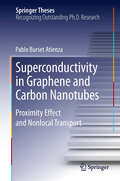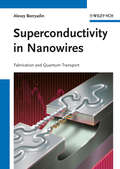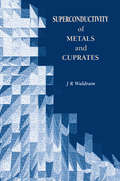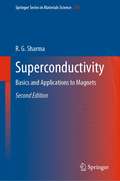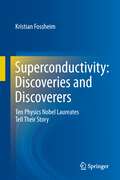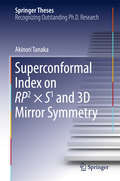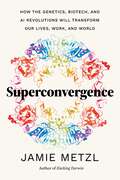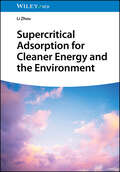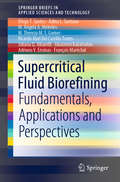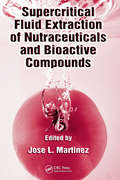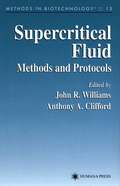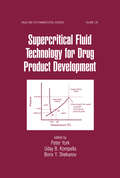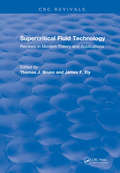- Table View
- List View
Supercomputing for Molecular Dynamics Simulations
by Alexander Heinecke Wolfgang Eckhardt Martin Horsch Hans-Joachim BungartzThis work presents modern implementations of relevant molecular dynamics algorithms using ls1 mardyn, a simulation program for engineering applications. The text focuses strictly on HPC-related aspects, covering implementation on HPC architectures, taking Intel Xeon and Intel Xeon Phi clusters as representatives of current platforms. The work describes distributed and shared-memory parallelization on these platforms, including load balancing, with a particular focus on the efficient implementation of the compute kernels. The text also discusses the software-architecture of the resulting code.
Superconducting Devices in Quantum Optics
by Robert H. Hadfield Göran JohanssonThis book presents the basics and applications of superconducting devices in quantum optics. Over the past decade, superconducting devices have risen to prominence in the arena of quantum optics and quantum information processing. Superconducting detectors provide unparalleled performance for the detection of infrared photons in quantum cryptography, enable fundamental advances in quantum optics, and provide a direct route to on-chip optical quantum information processing. Superconducting circuits based on Josephson junctions provide a blueprint for scalable quantum information processing as well as opening up a new regime for quantum optics at microwave wavelengths. With recent advances in coherent conversion between telecom and microwave frequencies, it is possible to envisage the marriage of these approaches, as superconducting qubits are embedded in long distance fiber optic communications networks. This volume, edited by two leading researchers, provides a timely compilation of contributions from top groups worldwide across this dynamic field, anticipating future advances in this domain.
Superconducting Magnetic Energy Storage Systems (SpringerBriefs in Energy)
by Antonio Colmenar-Santos Enrique Rosales-Asensio Enrique-Luis Molina-IbáñezThis book explores the potential of magnetic superconductors in storage systems, specifically focusing on superconducting magnetic energy storage (SMES) systems and using the Spanish electricity system, controlled by Red Eléctrica de España (REE), as an example.The book provides a comprehensive analysis of the economic costs associated with the manufacture and maintenance of SMES systems, as well as a regulatory analysis for their implementation in the complex Spanish electrical system. The analysis also compares this system with the regulations of other countries, providing a comprehensive case study.The book examines the possible economic and environmental benefits of using magnetic superconductors in electrical systems and provides a technical study of the use of these systems in hybrid storage systems that complement each other to optimize network performance. The study is conducted from the perspective of new distribution networks, distributed generation, and the concepts of the smart city. The book also explores potential applications and developments, such as electric vehicles.Overall, this book offers an insightful and comprehensive analysis of the potential of magnetic superconductors in storage systems. It will be an invaluable resource for researchers, engineers, and policymakers interested in the future of energy storage systems
Superconducting Materials: Fundamentals, Synthesis and Applications
by Yassine Slimani Essia HannachiThis book presents an overview of the science of superconducting materials. It covers the fundamentals and theories of superconductivity. Subjects of special interest involving mechanisms of high temperature superconductors, tunneling, transport properties, magnetic properties, critical states, vortex dynamics, etc. are present in the book. It assists as a fundamental resource on the developed methodologies and techniques involved in the synthesis, processing, and characterization of superconducting materials. The book covers numerous classes of superconducting materials including fullerenes, borides, pnictides or iron-based chalcogen superconductors ides, alloys and cuprate oxides. Their crystal structures and properties are described. Thereafter, the book focuses on the progress of the applications of superconducting materials into superconducting magnets, fusion reactors, and accelerators and other superconducting magnets. The applications also cover recent progress in superconducting wires, power generators, powerful energy storage devices, sensitive magnetometers, RF and microwave filters, fast fault current limiters, fast digital circuits, transport vehicles, and medical applications.
Superconducting Memory Technologies (Synthesis Lectures on Emerging Engineering Technologies)
by Ahmedullah Aziz Shamiul AlamThere is a lot of excitement around quantum computers that use superconducting qubits, which operate at extremely low temperatures since they are ultra-sensitive to noise. These quantum computers need a memory and control processor that can operate under cryogenic conditions. Among the cryogenic memory technologies, superconducting memories are the most efficient and compatible for these purposes. They can help advance quantum computing, facilitate high-performance computing, and explore space more effectively. However, cryogenic memory technologies currently face various challenges. This book discusses the latest advancements in superconducting memory technologies. It covers four main types of superconducting memories: Josephson junction-based, magnetic Josephson junction-based, superconducting memristor-based, and ferroelectric superconducting quantum interference device-based memories. The book explores the background, working principles, and challenges of each of these technologies, providing a comprehensive overview of the field.
Superconducting Radiofrequency Technology for Accelerators: State of the Art and Emerging Trends
by Hasan PadamseeSuperconducting Radiofrequency Technology for Accelerators Single source reference enabling readers to understand and master state-of-the-art accelerator technology Superconducting Radiofrequency Technology for Accelerators provides a quick yet thorough overview of the key technologies for current and future accelerators, including those projected to enable breakthrough developments in materials science, nuclear and astrophysics, high energy physics, neutrino research and quantum computing. The work is divided into three sections. The first part provides a review of RF superconductivity basics, the second covers new techniques such as nitrogen doping, nitrogen infusion, oxide-free niobium, new surface treatments, and magnetic flux expulsion, high field Q slope, complemented by discussions of the physics of the improvements stemming from diagnostic techniques and surface analysis as well as from theory. The third part reviews the on-going applications of RF superconductivity in already operational facilities and those under construction such as light sources, proton accelerators, neutron and neutrino sources, ion accelerators, and crab cavity facilities. The third part discusses planned accelerator projects such as the International Linear Collider, the Future Circular Collider, the Chinese Electron Positron Collider, and the Proton Improvement Plan-III facility at Fermilab as well as exciting new developments in quantum computing using superconducting niobium cavities. Written by the leading expert in the field of radiofrequency superconductivity, Superconducting Radiofrequency Technology for Accelerators covers other sample topics such as: Fabrication and processing on Nb-based SRF structures, covering cavity fabrication, preparation, and a decade of progress in the field SRF physics, covering zero DC resistance, the Meissner effect, surface resistance and surface impedance in RF fields, and non-local response of supercurrent N-doping and residual resistance, covering trapped DC flux losses, hydride losses, and tunneling measurements Theories for anti-Q-slope, covering the Xiao theory, the Gurevich theory, non-equilibrium superconductivity, and two fluid model based on weak defects Superconducting Radiofrequency Technology for Accelerators is an essential reference for high energy physicists, power engineers, and electrical engineers who want to understand the latest developments of accelerator technology and be able to harness it to further research interest and practical applications.
Superconductivity
by Reinhold Kleiner Rudolf Huebener W. BuckelThe third edition of this proven text has been developed further in both scope and scale to reflect the potential for superconductivity in power engineering to increase efficiency in electricity transmission or engines. The landmark reference remains a comprehensive introduction to the field, covering every aspect from fundamentals to applications, and presenting the latest developments in organic superconductors, superconducting interfaces, quantum coherence, and applications in medicine and industry. Due to its precise language and numerous explanatory illustrations, it is suitable as an introductory textbook, with the level rising smoothly from chapter to chapter, such that readers can build on their newly acquired knowledge. The authors cover basic properties of superconductors and discuss stability and different material groups with reference to the latest and most promising applications, devoting the last third of the book to applications in power engineering, medicine, and low temperature physics. An extensive list of more than 350 references provides an overview of the most important publications on the topic. A unique and essential guide for students in physics and engineering, as well as a reference for more advanced researchers and young professionals.
Superconductivity Of Metals And Alloys (Advanced Books Classics Ser.)
by P. G. De GennesDrawn from the author's introductory course at the University of Orsay, Superconductivity of Metals and Alloys is intended to explain the basic knowledge of superconductivity for both experimentalists and theoreticians. These notes begin with an elementary discussion of magnetic properties of Type I and Type II superconductors. The microscopic theory is then built up in the Bogolubov language of self-consistent fields. This text provides the classic, fundamental basis for any work in the field of superconductivity.
Superconductivity Revisited
by Ralph Dougherty J. Daniel KimelWhile the macroscopic phenomenon of superconductivity is well known and in practical use worldwide, the current theoretical paradigm for superconductivity suffers from a number of limitations. For example, there is no currently accepted theoretical explanation for the pattern of superconductor critical temperatures in the periodic table. Historical
Superconductivity and Electromagnetism (Springer Series in Solid-State Sciences #195)
by Teruo MatsushitaThis book introduces readers to the characteristic features of electromagnetic phenomena in superconductivity. It first demonstrates not only that the diamagnetism in the superconductivity complies with Maxwell’s theory, which was formulated before the discovery of superconductivity, but also that the dominant E-B analogy in the electromagnetism loses perfection without the superconductivity. The book then explores flux pinning, which is responsible for the non-dissipative current in DC, leading to irreversibility in AC. Drawing on Maxwell’s work, it also proves theoretically that if there is no energy dissipation in the superconductivity caused by the break in time reversal symmetry, it contradicts the thermodynamic principle of energy conservation – something that had previously only been proved experimentally.Lastly, the book addresses the longitudinal magnetic field effect, and explains how this phenomenon leads to a new development of Maxwell’s theory. Featuring numerous appendices to help readers understand the methods of derivation of equations, this book offers students and young scientists an introduction to applied superconductivity, especially in the context of power applications. Presenting the characteristic features of electromagnetic phenomena in superconductivity from basic to advanced topics for applications, the book offers a valuable resource for graduate students and researchers studying superconductivity as well as engineers working in electric utility industry.
Superconductivity and Magnetism in Skutterudites
by Ctirad UherSuperconductivity and Magnetism in Skutterudites discusses superconducting and magnetic properties of a class of materials called skutterudites. With a brief introduction of the fundamental structural features of skutterudites, the book then provides a detailed assessment of the superconducting and magnetic properties, focusing particularly on the rare earth-filled skutterudites where a plethora of fascinating properties and ground states is realized due to interactions of the filler species with the framework ions. Such interactions underpin the exciting forms of superconductivity and magnetism, most notably realized in the exotic heavy fermion superconductor of composition PrOs4Sb12. The two main topics of superconductivity and magnetism are provided with a concise introduction of superconducting and magnetic properties so that a reader can appreciate and understand the main arguments in the text. This book would appeal to graduate students, postdoctoral students, and anyone interested in superconducting and magnetic properties of a large family of minerals called skutterudites. Key Features:• Gives a thorough account of the superconducting and magnetic properties of skutterudites. • Each topic is accompanied by introductory sections to assist in the understanding of the text. • Supported by numerous figures and all key references.
Superconductivity in Graphene and Carbon Nanotubes
by Pablo Burset AtienzaThe unique electronic band structure of graphene gives rise to remarkable properties when in contact with a superconducting electrode. In this thesis two main aspects of these junctions are analyzed: the induced superconducting proximity effect and the non-local transport properties in multi-terminal devices. For this purpose specific models are developed and studied using Green function techniques, which allow us to take into account the detailed microscopic structure of the graphene-superconductor interface. It is shown that these junctions are characterized by the appearance of bound states at subgap energies which are localized at the interface region. Furthermore it is shown that graphene-supercondutor-graphene junctions can be used to favor the splitting of Cooper pairs for the generation of non-locally entangled electron pairs. Finally, using similar techniques the thesis analyzes the transport properties of carbon nanotube devices coupled with superconducting electrodes and in graphene superlattices.
Superconductivity in Nanowires: Fabrication and Quantum Transport
by Alexey BezryadinThe importance and actuality of nanotechnology is unabated and will be for years to come. <P><P>A main challenge is to understand the various properties of certain nanostructures, and how to generate structures with specific properties for use in actual applications in Electrical Engineering and Medicine.One of the most important structures are nanowires, in particular superconducting ones. They are highly promising for future electronics, transporting current without resistance and at scales of a few nanometers. To fabricate wires to certain defined standards however, is a major challenge, and so is the investigation and understanding of these properties in the first place. A promising approach is to use carbon nanotubes as well as DNA structures as templates.Many fundamental theoretical questions are still unanswered, e.g. related to the role of quantum fluctuations. This work is tackling them and provides a detailed analysis of the transport properties of such ultrathin wires. It presents an account of theoretical models, charge transport experiments, and also conveys the latest experimental findings regarding fabrication, measurements, and theoretical analysis. In particular, it is the only available resource for the approach of using DNA and carbon nanotubes for nanowire fabrication.It is intended for graduate students and young researchers interested in nanoscale superconductivity. The readers are assumed to have knowledge of the basics of quantum mechanics and superconductivity.
Superconductivity of Metals and Cuprates
by J.R WaldramSuperconductivity of Metals and Cuprates covers the basic physics of superconductivity, both the theoretical and experimental aspects. The book concentrates on important facts and ideas, including Ginzburg-Landau equations, boundary energy, Green's function methods, and spectroscopy. Avoiding lengthy or difficult presentations of theory, it is written in a clear and lucid style with many useful, informative diagrams. The book is designed to be accessible to senior undergraduate students, making it a helpful tool for teaching superconductivity as well as serving as an introduction to those entering the field.
Superconductivity: Basics and Applications to Magnets (Springer Series in Materials Science #214)
by R.G. SharmaThis book presents the basics of superconductivity and applications of superconducting magnets. It explains the phenomenon of superconductivity, describes theories of superconductivity, and discusses type II and high-temperature cuprate superconductors. The main focus of the book is the application of superconducting magnets in accelerators, fusion reactors and other advanced applications such as nuclear magnetic resonance (NMR), magnetic resonance imaging (MRI), high-gradient magnetic separation (HGMS), and superconducting magnetic energy storage (SMES). This new and significantly extended second edition covers the state of the art in the development of novel superconductors for advanced magnet applications, as well as the production of practical superconducting wires, tapes, and ultra high current cables used for high-field magnets. It includes two new chapters each devoted to MgB2 and Fe-based superconductors, and discusses the recently developed and world record-setting 45.5-Tesla magnetic field generated by a combination of conventional and high-temperature cuprate superconducting magnets. In addition, it discusses the status and outlook of all current and future nuclear fusion reactors worldwide. The chapter on accelerators includes the ongoing efforts to build high luminosity LHC (HL-LHC), the high-energy 28 TeV LHC (HE-LHC), the future circular collider (FCC) at CERN, and the just launched electro-ion collider (EIC) at Brookhaven National Laboratory. The book is based on the long-standing experience of the author in studying superconducting materials, building magnets and delivering numerous lectures to research scholars and students. The book provides comprehensive and fundamental knowledge in the field of applied superconductivity, greatly benefiting researchers and graduate students wishing to learn more about the various aspects of superconductivity and advanced magnet applications.
Superconductivity: Discoveries and Discoverers
by Kristian FossheimThis book is about the work of 10 great scientists; who they were and are, their personal background and how they achieved their outstanding results and took their prominent place in science history. We follow one of physics and science history's most enigmatic phenomena, superconductivity, through 100 years, from its discovery in 1911 to the present, not as a history book in the usual sense, but through close ups of the leading characters and their role in that story, the Nobel laureates, who were still among us in the years 2001-2004 when the main round of interviews was carried out. Since then two of them already passed away. For each one of the 10 laureates, the author tells their story by direct quotation from interviews in their own words. Each chapter treats one laureate. The author first gives a brief account of the laureates' scientific background and main contribution. Then each laureate tells his own story in his own words. This book is unique in its approach to science history.
Superconformal Index on RP2 × S1 and 3D Mirror Symmetry
by Akinori TanakaThe author introduces the supersymmetric localization technique, a new approach for computing path integrals in quantum field theory on curved space (time) defined with interacting Lagrangian. The author focuses on a particular quantity called the superconformal index (SCI), which is defined by considering the theories on the product space of two spheres and circles, in order to clarify the validity of so-called three-dimensional mirror symmetry, one of the famous duality proposals. In addition to a review of known results, the author presents a new definition of SCI by considering theories on the product space of real-projective space and circles. In this book, he explains the concept of SCI from the point of view of quantum mechanics and gives localization computations by reducing field theoretical computations to many-body quantum mechanics. He applies his new results of SCI with real-projective space to test three-dimensional mirror symmetry, one of the dualities of quantum field theory. Real-projective space is known to be an unorientable surface like the Mobius strip, and there are many exotic effects resulting from Z2 holonomy of the surface. Thanks to these exotic structures, his results provide completely new evidence of three-dimensional mirror symmetry. The equivalence expected from three-dimensional mirror symmetry is transformed into a conjectural non-trivial mathematical identity through the new SCI, and he performs the proof of the identity using a q-binomial formula.
Superconvergence: How the Genetics, Biotech, and AI Revolutions Will Transform our Lives, Work, and World
by Jamie Metzl"Superconvergence is brilliant. I can't recommend it more strongly."―Sanjay Gupta MD, bestselling author, neurosurgeon, and Emmy-award winning chief medical correspondent (CNN) In Superconvergence, leading futurist and OneShared.World founder Jamie Metzl explores how artificial intelligence, genome sequencing, gene editing, and other revolutionary technologies are transforming our lives, world, and future. These accelerating and increasingly interconnected technologies have the potential to improve our health, feed billions of people, supercharge our economies, store essential information for millions of years, and save our planet, but they can also―if we are not careful―do immeasurable harm. The challenge we face is that while our ability to engineer the world around us is advancing exponentially, our processes for understanding the scope, scale, and implications of these changes, and for managing our godlike powers wisely, are only inching forward glacially. Luckily, in Jamie Metzl, we have a leading expert who integrates science, technology, history, politics, and international affairs to envision a future that most specialists, almost by definition, cannot see. In this bold and inspiring exploration of transformative human knowledge, Metzl gives us the definitive account of the technological precipice on which we stand and the map to where we go from here.
Supercritical Adsorption for Cleaner Energy and the Environment
by Li ZhouComprehensive and technically detailed approach to addressing environmental and energy challenges through the advance of adsorption theory and techniques Supercritical Adsorption for Cleaner Energy and the Environment delves into the novel theory of supercritical adsorption and its practical applications in energy and environmental management issues. The book addresses critical topics such as supercritical adsorption and sustainable energy solutions, provides a deep understanding of advanced theories and techniques of supercritical adsorption, and addresses innovative methods for fuel desulfurization, natural gas storage, hydrogen energy, and emission-free coal power generation in the energy industry. The book is divided into two parts. The first part provides a comprehensive theory of supercritical adsorption, illustrated with examples that showcase significant progress in both applied and theoretical research due to recent advancements. Building on this theoretical foundation, the second part demonstrates how supercritical adsorption theory can address research questions in the fields of energy and environmental science. Supercritical Adsorption for Cleaner Energy and the Environment includes information on: Solutions for theoretical problems of supercritical adsorption, such as determination of absolute adsorption and the volume or density of the adsorbed phase Adsorptive technology to enhance natural gas storage, and methane enrichment from low-quality gas Ideas, chemical reactions, and materials and adsorbents used in supercritical adsorption research with the potential to transform approaches in environmental challenges Efficient and feasible strategies for achieving carbon circulation within the energy consumption and generation cycle Supercritical Adsorption for Cleaner Energy and the Environment is an essential forward-thinking reference for practitioners and researchers in the fields of chemistry, chemical engineering, energy, and environmental science.
Supercritical Antisolvent Precipitation Process: Fundamentals, Applications and Perspectives (SpringerBriefs in Applied Sciences and Technology)
by Diego T. Santos Ádina L. Santana M. Angela Meireles Ademir José Petenate Eric Keven Silva Juliana Q. Albarelli Júlio C. Johner M.Thereza M. S. Gomes Ricardo Abel Torres Tahmasb HatamiThis book provides deep insights on the fundamentals, applications and perspectives of the Supercritical AntiSolvent (SAS) Precipitation Process. Chapter 1 provides recent (2013-2018) reports on the use of supercritical CO2 (SC-CO2) antisolvent for micronization, coprecipitation and fractionation of high-value products for the food, cosmetic and pharmaceutical industries. Chapter 2 discusses another variant of the SAS precipitation process called Supercritical fluid extraction of emulsions (SFEE). This chapter provides recent data from 2016-2018 reports investigation of supercritical extraction of emulsions (SFEE) to encapsulate compounds of great interest to the food and non-food industry. Chapter 3 details the design and construction of a SAS Precipitation equipment. Chapter 4 presents experimental results regarding the validation of the supercritical particle formation equipment. Chapter 5 shows the effects of process parameters during particle precipitation using Combined High Turbulence Extraction Assisted by Ultrasound and Supercritical Antisolvent Fractionation (SAF) processes applied to semi-defatted annatto seeds, as a model raw material plant, were investigated. Chapter 6 shows experimental results regarding the process Ultrasound Emulsification Assisted by Nitrogen Hydrostatic Pressure (UEANHP), during the emulsification preparation step of the Supercritical Fluid Extraction of Emulsions (SFEE) process, one of the options of the SAS Precipitation-based process. Finally, Chaptesr 7 and 8 present some perspectives about the economics and process integration with other processes aiming the development of novel conceptual biorefinering approaches for plant materials valorization.
Supercritical Fluid Biorefining: Fundamentals, Applications and Perspectives (SpringerBriefs in Applied Sciences and Technology)
by Diego T. Santos Ádina L. Santana M. Angela Meireles Juliana Q. Albarelli Ricardo Abel Torres M. Thereza Gomes Aikaterini Bakatselou Adriano V. Ensinas François MaréchalThis book provides deep insights about the fundamentals, applications and perspectives of the use of supercritical CO2 as solvent and antisolvent for biorefinering.
Supercritical Fluid Extraction of Nutraceuticals and Bioactive Compounds
by Jose L. MartínezEnhanced concern for the quality and safety of food products, increased preference for natural products, and stricter regulations on the residual level of solvents, all contribute to the growing use of supercritical fluid technology as a primary alternative for the extraction, fractionation, and isolation of active ingredients. As a solvent-free p
Supercritical Fluid Methods and Protocols
by Anthony A. Clifford John R. WilliamsExperienced practitioners present detailed accounts of a wide variety of techniques using supercritical fluids. These range from the supercritical fluid extraction methods for numerous compounds to the ninhydrin staining of fingerprints on checks and banknotes-and from the detection of impurities in pharmaceuticals to a wide variety of applications throughout environmental and food science, and across analytical, clinical, and medicinal chemistry. Detailed step-by-step instructions enable users to apply these essential techniques successfully the first time and include modifications that permit their effective adaptation to novel experimental or process conditions. Versatile and comprehensive, Supercritical Fluid Methods and Protocols offers both novice and experienced investigators and laboratory analysts powerful tools that enable successful biological and bioprocess analyses and optimization today.
Supercritical Fluid Technology for Drug Product Development
by Uday B. Kompella Peter York Boris Y. ShekunovInterconnecting the fundamentals of supercritical fluid (SCF) technologies, their current and anticipated utility in drug delivery, and process engineering advances from related methodological domains and pharmaceutical applications, this volume unlocks the potential of supercritical fluids to further the development of improved pharmaceutical prod
Supercritical Fluid Technology: Reviews in Modern Theory and Applications (CRC Press Revivals)
by Thomas J. Bruno James F. ElyIn this volume, we have collected a series of reviews that cover both experimental and theoretical work geared toward the more exact requirements of current SFE applications. While we have artificially divided the volume into experimental and theoretical sections, natural overlaps will be apparent. Many of the papers on experimental and theoretical sections, natural overlaps will be apparent. Many of the papers on experimental technique contain discussions on equation of state correlations. Indeed, a good deal of the experimental work is intimately tied to a mathematical description of fluid mixtures. The theoretical section presents reviews that cover the modern theory of critical phenomena, methods to correlate near critical experimental results and approaches to understanding the behavior of near critical fluids from microscopic theory. It is hoped that the scope of these reviews will provide the reader with the basis to further develop our understanding of the behavior of supercritical fluids.
